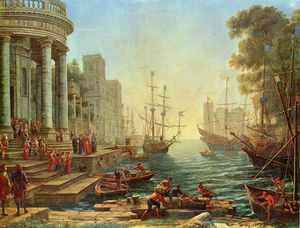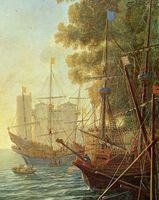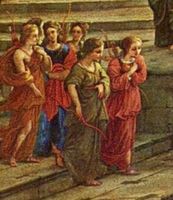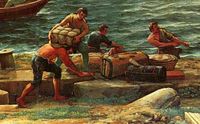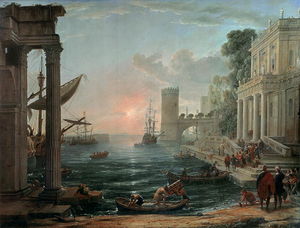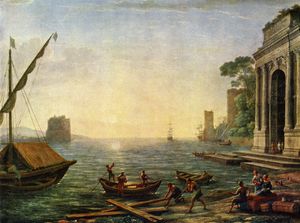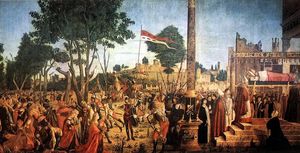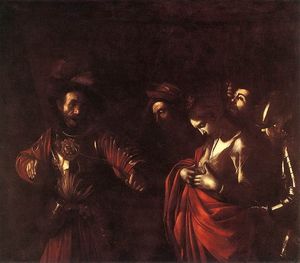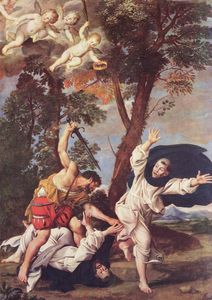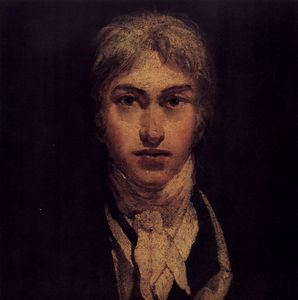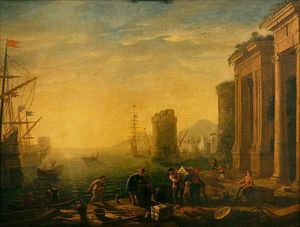Seaport with the Embarkation of Saint Ursula
- Date of Creation:
- 1641
- Height (cm):
- 112.90
- Length (cm):
- 149.00
- Medium:
- Oil
- Support:
- Canvas
- Subject:
- Landscapes
- Art Movement:
- Baroque
- Created by:
- Seaport with the Embarkation of Saint Ursula Page's Content
- Story / Theme
- Analysis
- Related Paintings
- Artist
- Art Period
- Bibliography
Seaport with the Embarkation of Saint Ursula Story / Theme
One of Claude's early successes, Seaport with the Embarkation of St. Ursula depicts a scene from the legendary life of Saint Ursula as narrated by Jacopo da Varagine's Golden Legend.
The tale is not accepted as official church doctrine, due to the numerous versions of the story that exist, but the version from the Golden Legend goes something like this: Saint Ursula was the daughter of the King of Britain, Donaut of Dumnonia. When Ursula was engaged to the pagan governor, Conan Meriadoc of Armorica, she set sail to meet her future husband with some astounding companions: 11,000 virgins, to be exact.
Like most good Christian martyrs, however, Ursula was devoted to her virginity and loath to marry a pagan man, so to stall for time she declared that she would take an around-Europe pilgrimage. After stopping over in Rome and explaining her problem to the ecclesiastical authorities, Ursula and her troops headed over to Cologne, which was unfortunately under siege by the Huns at that time.
Some versions of the legend hold that the King of the Huns was mesmerized by Ursula's beauty and was determined to take her as a wife; when she refused, he shot her through the heart with an arrow, and the rest of the virgins were similarly slaughtered (either beheaded or shot with arrows, depending on the version of the story). Saint Ursula's feast day is October 21.
The Commission:
Claude Lorrain painted Seaport with the Embarkation of St. Ursula in 1641 for Fausto Poli, secretary to Pope Urban VIII (another patron of Claude's). Poli's main responsibility was to buy and commission works of art for his boss, a notoriously avid collector; his success at building one of the most magnificent collections of the 17th century was rewarded with an appointment as cardinal in 1643. Poli was also a patron of the star Italian Baroque sculptor Bernini.
Seaport with the Embarkation of Saint Ursula Analysis
Claude Lorrain's Seaport with the Embarkation of St. Ursula comes after both Carpaccio's painting and Caravaggio's piece, and represents an entirely different mode of representation. Gone are the grisly scenes of torture and martyrdom; in their place, a serene tranquility, with hardly a hint of the horror to come. Claude's Saint Ursula stands out for the following qualities;
The dramatic moment:
Unlike previous artists, Claude chooses not to depict the most dramatic moment of St. Ursula's life story, namely, the massacre. Instead, Claude chooses to depict the moment when Ursula and her maidens are about to depart Rome for Cologne.
The scene is one of utter tranquility and calm; indeed, it is virtually impossible to identify the subject of the painting without the help of its title. Saint Ursula is identifiable by her yellow dress and flag while some of her maidens are equipped with the bows and arrows that are the symbols of their martyrdom. This is utterly characteristic of Claude's style: his paintings may tend towards the wistful or melancholy in tone, but they never veer into the violent, dramatic or erotic.
A classical setting:
The foreground is busy with the various activities of the seamen and maidens as they prepare for departure, while the classical architecture to the left of the picture plane and the foliage to the right help to lead the viewer's eye into the background. Classical architecture and ruins often appear in Claude's landscapes, as they do in the paintings of fellow French Baroque expatriate Nicolas Poussin.
Both of these artists represent the classicizing strain of Baroque art, and as young men would roam the Roman countryside (or Campagna) together, sketching landscapes and ruins alike.
Soft, misty light:
Light is always the most important element in any of Claude's paintings, and Seaport with the Embarkation of St. Ursula is no exception. The painting seems to be illuminated by the misty light of dawn; the artist always depicts either dawn or twilight, which he found to be the most poetic times of day.
Few painters in the history of art have managed to achieve the incredibly subtle, sophisticated effects of light that Claude has. He managed to paint amazingly soft, glowing light thanks to his meticulous, painstaking techniques.
Seaport with the Embarkation of Saint Ursula Related Paintings
Seaport with the Embarkation of Saint Ursula Artist
Seaport with the Embarkation of St. Ursula is an example of a genre of painting invented by Claude Lorrain: the seaport. The 1640s saw a real shift in Claude Lorrain's painting production. After the bustling activity of the previous decade, during this period Claude began to slow down.
He reduced his patrons to only the most elite, and began painting fewer, but much larger, more intricate paintings. Having lived in Rome for over ten years by now, the northern style that had informed Claude's earlier paintings was replaced by an Italianate classicism borrowed from Bolognese landscape painters Annibale Carracci and Domenichino.
Although landscape painting was long perceived as a "lesser" genre, Lorrain achieved enormous success in his own lifetime, and his eerily beautiful landscape paintings have enchanted the art-loving public for centuries, making this French painter one of the most widely beloved artists of the Baroque.
Building on the base of the ideal landscape created by his predecessors and contemporaries Claude Lorrain was perhaps the most influential landscape painter in the history of art and paved the way for generations of landscape painters to come.
Claude had some immediate followers in Italy and France in the late 17th and early 18th centuries (most notably his pupil, Angeluccio, Salvatore Rosa, and Claude Joseph Vernet), but Claude's greatest influence was felt in England. Claude's paintings impacted all aspects of English culture, from literature to garden design, and English artists were by no means immune to this influence. Claude's most important English disciples include the phenomenal Romantic artists J. M.W. Turner, John Constable, and Samuel Palmer.
Claude Lorrain's paintings are perfect examples of the genre known as the idealized landscape and are simultaneously rooted in a strong naturalism, but beautified and idealized; Claude never shows the world's harsh realities, but instead a perfect image of nature as it should be.
Seaport with the Embarkation of Saint Ursula Art Period
Claude Lorrain was one of the great painters of the French Baroque. Like his contemporary and close friend Nicolas Poussin, however, Claude actually spent the majority of his life and career in Rome, not in France; nonetheless, Claude's early childhood in the tumultuous region of la Lorraine would undoubtedly have had an effect on the artist. Along with Poussin, Claude helped to define the classicizing tendencies of French Baroque art.
Claude's style and subjects are perhaps more consistent throughout his oeuvre than those of virtually any other artist, but that is not to say that there is no evolution in Claude's paintings. On the contrary, a careful look at his works reveals a rather surprising artistic journey.
Claude's early paintings are steeped in the northern European landscape tradition, complete with charming picturesque details and compositional surprises. As is unsurprising for an artist who studied and worked in Rome, however, as Claude matured his paintings became increasingly classical in tone and theme.
The later works are cooler and more idealized, and exude a more melancholy, wistful atmosphere than the more cheerful, bustling early pictures.
Seaport with the Embarkation of Saint Ursula Bibliography
To read more about Claude Lorrain please choose from the following recommended sources.
• Askew, Pamela, ed. Claude Lorrain: 1600-1682: a symposium. Washington: National Gallery of Art, 1984
• Grahame, George. Claude Lorrain, Painter and Etcher. Seeley and Co. , 1895
• Lagerlöf, Margaretha Rossholm Ideal Landscape: Annibale Carracci, Nicolas Poussin, and Claude Lorrain. Yale University Press, 1990
• Mannocci, Lino. The Etchings of Claude Lorraine. Yale University Press, 1988
• Rand, Richard. Claude Lorrain: The Painter as Draftsman. Yale University Press, 2007
• Röthlisberger, Marcel. Claude Lorrain: The Paintings. Hawker Art Books, 1979
• Russell, Helen Diane. Claude Lorrain, 1600-1682. Washington : National Gallery of Art, 1982
• Wine, H. Claude : The Poetic Landscape. London: National Gallery, 1994

